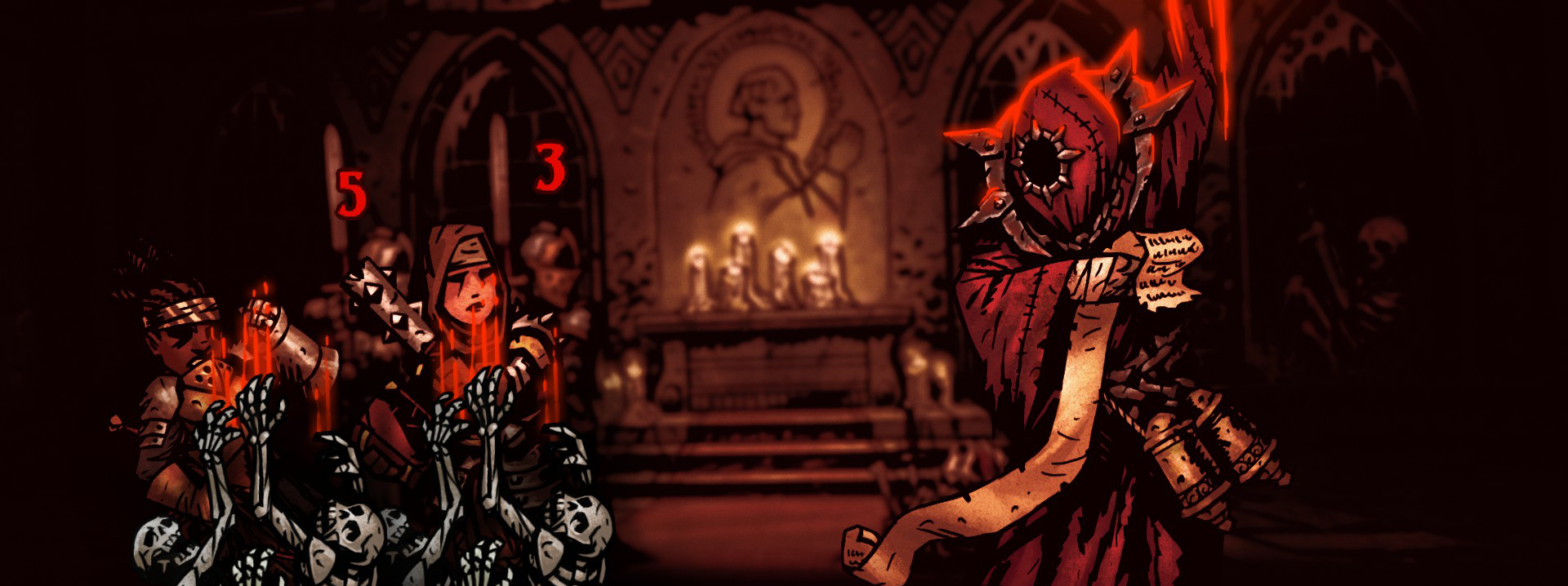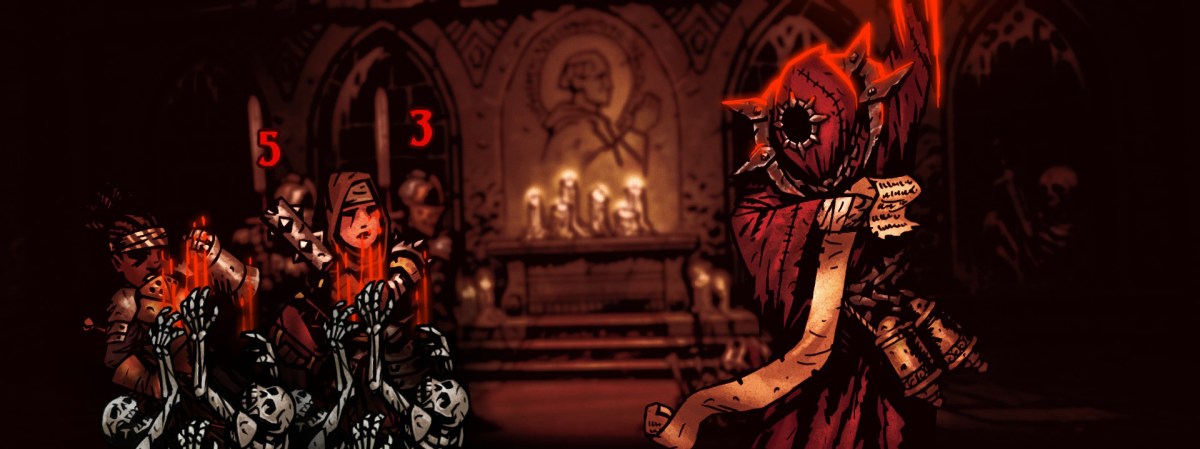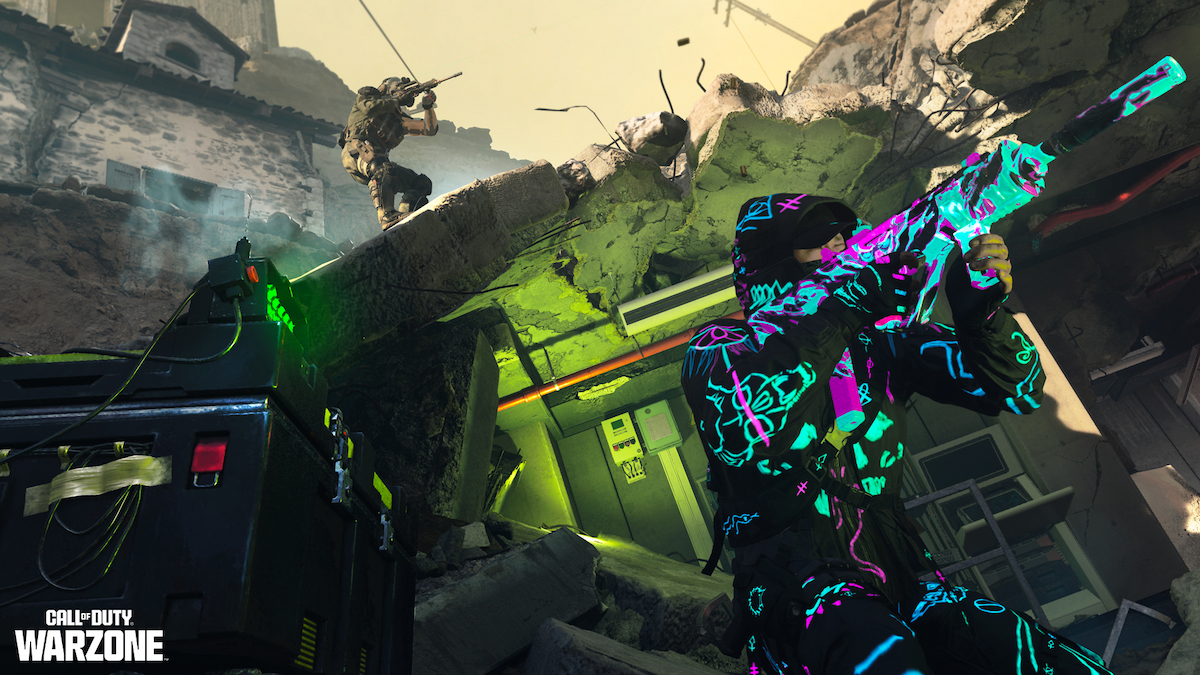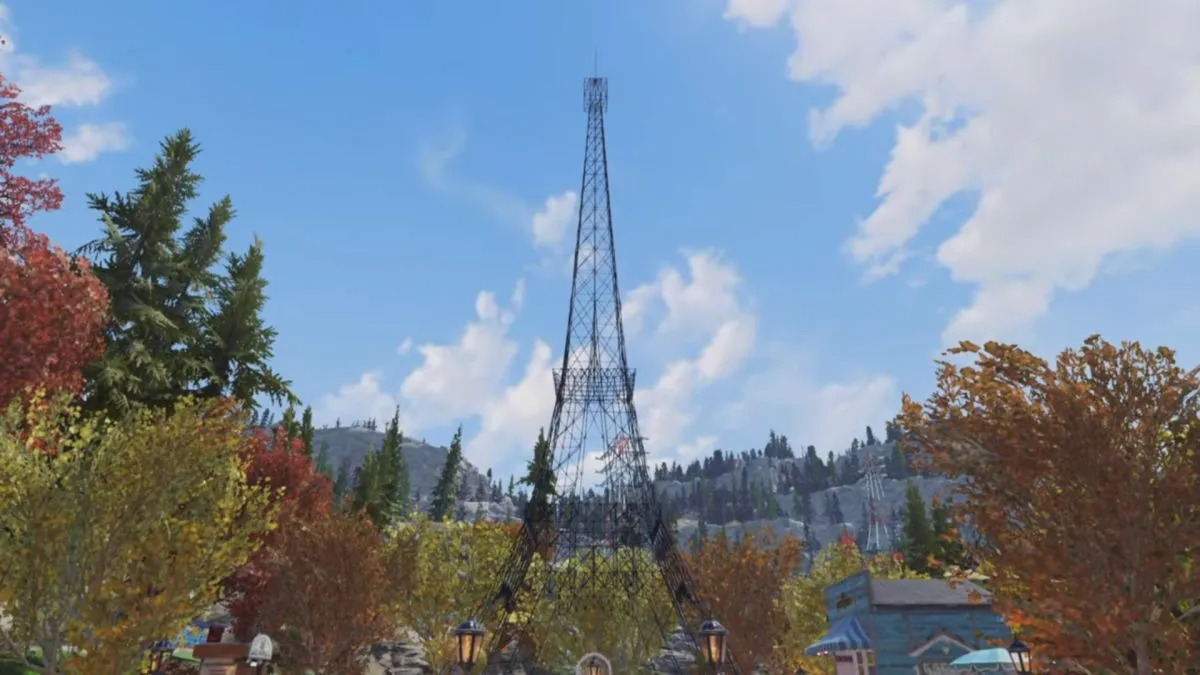What we are in the dark
Most games gloss right over the psychological effects of combat and stress. RPGs see parties of cheery young adventurers slaughter their way through entire countrysides worth of kobolds and giant rats for the sake of justice and good. Nathan Drake, with his ability to break a man’s neck one minute and make a lighthearted quip the next, is the poster child for video game psychopathy. Violence is neatly compartmentalized in one area, and the personality and sanity of the protagonists are kept safely quarantined away in another, never to meet.
Not so in Darkest Dungeon. There are no doe-eyed youths fighting for justice to be found, only grizzled veterans, zealots, and criminals who share a lust for coin. The quips are limited to vicious cursing, gleeful celebrations of cruelty after a precision strike, and the occasional surprised exclamation that something good has happened for once. The violence of your ancestor’s grand estate, overrun with monsters and turned into a pit of terror and malice, crashes full-on into the psyche of your mercenaries, leaving them ruined, shaking, hollowed-out shells of themselves. It’s madness.
But, in what is perhaps the most disturbing revelation Darkest Dungeon bestows, there is a dark joy to be found in madness.

Darkest Dungeon (PC)
Developer: Red Hook Studios
Publisher: Red Hook Studios
Released: January 19, 2016
MSRP: $19.99
Darkest Dungeon is an absolutely merciless exercise in roguelike themes. It is all about micromanagement, skillful use of scarce resources, determination in the face of insurmountable odds, and the ability to press on after a particularly bad roll of the RNG wipes out your All-Star squad of heroes. Make no mistake, it can be frustrating. Unlike other roguelikes you may have played where the whims of fortune sabotage a 30-minute run or one mission, Darkest Dungeon has no problem with wiping out hours of investment in a character or trinket. If that sounds like the kind of thing that would make you break your keyboard over your knee, consider a trip to the dungeon carefully. If you have a dark streak of sadism in you though, you may have just found your game.
While the game is certainly fiendish in its difficulty and brutal with its punishments, you’re not totally helpless to luck and chance. Darkest Dungeon is a game played in two distinct portions. The first is a sort of management and strategic level where you direct resources to different parts of your ancestral hamlet and roster of warriors. The other is the actual dungeon dive, the tactical application of all that planning and building, the individual choices of which hallway to go down, which darkened corner to peer into, and which enemy should be brought low in what order. Through skillful manipulation of both levels, victory can be snatched from seemingly impossible challenges.

In the hamlet, you are the omniscient master of the land, deciding who to hire, who to send on adventures, and which institutions to upgrade. Each aspect of the hamlet plays a crucial role in fighting the dark. The Stagecoach ferries fresh meat and raw recruits to bolster your ranks and replace the fallen. Services provided at the Guild and Blacksmith can improve your warriors’ skills and equipment. The Sanitarium will remove diseases of the mind and body (for a steep fee) that may otherwise render a hero useless. Of course, the Abbey and Bar are necessary to provide comfort, meaning, and solace to your men. Whether they relax through quiet meditation, or through the fleshy pleasures of the neighborhood brothel, paying for a few nights worth of recuperation can save them from breaking in the next dungeon.
Properly investing in the right aspects of your hamlet at the right time is just as important as making wise decisions in battle. All of the different services are desperately necessary and, especially at the beginning of the game, you’ll never have enough coin or heirlooms (different upgrade resources needed for different buildings) to maintain them all. You need to be crafty and shrewd, making your meager wealth stretch as far as it can go while knowing you are compromising in one area to prop up another.
The same merciless economics apply to your roster. Heroes cost a fortune to upgrade with better weapons and higher-level skills – an investment that can be lost in an instant to a bad battle. Otherwise potent warriors can also slowly become crippled by afflictions and phobias after too many trips to the dungeon, and while all maladies can be cured, the cost sometimes outweighs the benefit. Knowing when it’s best to spend money to rehabilitate a Crusader who picked up a drinking habit and fear of the occult after his last disastrous mission, or when to spend that money equipping and upgrading his replacement, is the pitiless key to progression.

In the dungeon, the emphasis switches from the overarching, to the granular. In the 2D side-to-side lineup of the characters, it is of the utmost importance to carefully consider where each of your heroes stands. Every hero and monster possesses skills that can only be used from one position or another that will only effect a foe standing in specific spots. Some of these can be quite general, for example being anywhere in the first few rows will generally let a Bounty Hunter attack anyone in the opposite first three rows. Contrarily, the Hellion with her swooping spear has a move that she can only use in the very first rank to attack the very last opponent. While it sounds needlessly obscure, that single move became one of my favorites in the entire game.
With 14 different classes to choose from, each of whom have seven possible combat skills that are all limited in terms of where they can be used and what they can hit, experimentation is key. There is no ideal team or strategy to be found. Different adventurers do better or worse in specific areas based on their damage type and common skills and you need to adjust. You can crutch on the Crusader and Vestal to wade through the skeletons of the Ruins with their extra damage against the unholy and the lack of nuance in the skeleton’s attack plan. When you get to the twisted mermen and giant crabs of the Cove however, you’ll want a strong Man-at-Arms to defend the front-line while a Plague Doctor hurls poison blight that will do more damage than any sword trying to pierce their scales.

While in most RPGs the heroes are never in danger from rank-and-file monsters, in Darkest Dungeon, every battle holds the potential for defeat – either from a splashy total party wipe, or the slow erosion of a party’s ability to press on.
Healing is an uphill climb. There are only a few classes capable of restoring other party members and their heals are meager or rely on swings of luck. Some characters are capable of healing themselves, but these are often front-line warriors who are better off attacking a monster than trying to frantically repair damage. You don’t recover anything after a battle, so a victory in the moment can set your party up for total defeat in the next if the enemy undermines you enough. Knowing when to abandon a quest and when to stick it out is an important judgment call, but while retreating may save your life, it also burdens the party with the stressful shame of coming back to town empty handed.
Stress is a significant factor in every battle. Some of the most dangerous and insidious monsters in the game have very weak attacks, but can do things that cause your party stress. When a hero reaches a critical point of stress, their resolve will be tested in a moment of truth. Sometimes a hero will have a moment of valiant triumph and when the abyss stares into them they will not blink, becoming stronger for the experience. All the more common though, the frailty of man is revealed and a warrior will suffer a psychological break.

An affliction of the mind is a terrible thing. Party members afflicted with paranoia, masochism, selfishness, or those who turn their abuse outward will drag the party down. They’ll disobey orders, refuse heals or buffs out of distrust and fear, hurl insults or sing mad ramblings that unnerve the other fighters. If you let them, a broken fighter will hamstring healthy ones. You either need to cure them or cut them loose.
Exploring each dungeon is done in a slightly odd manner. You always move across the screen in a straight line from left-to-right when traveling from hallways to rooms. A map grid lets you choose your route and with a little luck and a few stat-boosting skills, the occasional scouting report will let you see your opposition and potential treasure in advance. A torch light system dynamically changes the difficulty – the more well lit you keep the dungeon, the easier it is. Keep the light low and your party will quiver with fear and you’ll encounter stronger monsters, but the treasures to be found will be that much greater to reward your bravery.
Simply moving through these dungeons takes a toll on your adventurers. Stress accumulates as you dive deeper into the beast’s lair, and retreating only causes more. Traps litter each area. The observant explorer can disarm them with a little luck, but even the most wary party is likely to stumble into a few. Curiosities like ancient scrolls, pagan shrines, and freshly dug graves tempt the party to test fate as each oddity they encounter has the potential for reward or affliction. Reading an old scroll is as likely to provide insight as it is to shatter the mind with a grim revelation.

Properly provisioning your party with supplies helps tilt these odds in your favor. If you pack holy water, you can cleanse occult talismans. A shovel will let you pass an obstacle of rubble without stressing your party out by making them dig by hand. Bandages and medicinal herbs can staunch bleeding, remove debuffs, and allow the safe handling of unsanitary crevasses or torture equipment one may find in a dungeon.
At this point, I’m fine with everything Darkest Dungeon has to offer, even where I can see elements that will bother other players. I think the management aspect is interesting and I like that is pushes you to cultivate diverse teams and experiment even if some players will likely be annoyed that they can’t focus on a favored team composition. The battle system is fantastic, despite the occasional bad turns of luck that can feel unfair and some of the cheaper enemies that become more frustrating than thrilling.
Unfortunately, even while I enjoy those mechanics, Darkest Dungeon manages to wear out its welcome due to the sheer grind demanded of the player.

At certain points, when ascending to a new level plateau or encountering a new sort of boss, the difficulty spikes to a degree that is way out of hand. You’ll be thrilled when you get your first squad of adventurers to level three and they will no longer bother themselves with lower-level missions. A new challenge! Sadly, you’ll likely find that team totally unprepared for the newfound challenge and probably beat a hasty retreat or lose a few of them. With them now too weak to do the missions they are leveled for, and too haughty to deign running an easier mission, you’ll have to park them for hours as you grind other teams trying to find trinkets to give them the edge and upgrade the guild and blacksmith to a point where they can reach full potential.
The amount of busywork needed to prop up more valuable heroes and expand the hamlet becomes too much. Running squads of lowly heroes you have no intention of keeping just so you can get enough heirloom scrolls to level up the Blacksmith quickly devolves into tedium.
This is especially pronounced at the very end of the game where you need several fully leveled teams of four to take on the last series of missions. Not only are the missions tremendously difficult, but retreating from one guarantees one member will die. Adding to this, once a warrior successfully completes one of the final missions, they won’t go on another.
You end up in a situation where you can easily burn a team or two to a party wipe, easily lose one or two members to a retreat, and then end up with nobody suitable on the roster left to take on the next mission. Instead, you’re expected to grind yet more characters up to full level for another run. God help you if you lose your last Vestal and need to take a fresh healer from level zero to six. Eventually, the economy tends towards abundance and you’ll have plenty of gold to streamline the process as much as possible, but you’ll still need to run more than a dozen missions to get them fit for duty.

This is where Darkest Dungeon stumbles and my own mind turns to darkness. When I start the mental arithmetic of how much work it will take to just to make another attempt at the final dungeons, I reel and sputter. Hours and hours of stress and suffering just for a chance at the end? This is no way for rational people to spend their time. You’d have to be mad.
And yet you’ll do it. You’ll do it because at this point the game will have its hooks in you and you won’t be able to let go. If you’ve stuck with it to that point, you might grumble and moan like me, but you’ll press on. Maybe the developers meant for it to be so. A commentary on unhinged ambition, a way of making you feel as weary and beaten down as that Crusader nursing his second week in a row at the bar, dragging his feet towards another inevitable damned expedition.
Despite the grind, despite the perhaps undue commitment to brutality, and despite what I feel is a joke at the player’s expense at the end, Darkest Dungeon still manages to be one of the most engaging and intriguing roguelikes I’ve ever played and I’ll probably still be diving dungeons and trying new party compositions weeks from now. After all, it would be madness to stop at this point.
[This review is based on a retail build of the game provided by the publisher.]





